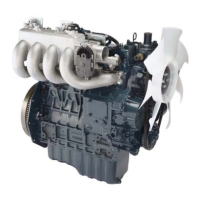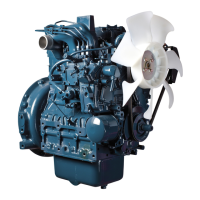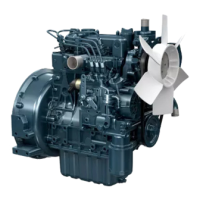
Do you have a question about the Kubota 07-CR-E5 and is the answer not in the manual?
| Number of Cylinders | 3 |
|---|---|
| Compression Ratio | 19.0:1 |
| Fuel System | Common rail system |
| Type | Vertical, water-cooled 4-cycle diesel |
| Lubrication System | Forced lubrication with trochoid pump |
| Starting System | Electric starter |
| Cooling System | Water-cooled |
| Emissions compliance | EU Stage V |
Instructions and safety guidelines for preparing the machine before servicing or repair.
Guidelines for safely starting the engine, emphasizing starter terminals and safety switches.
Precautions against fire hazards, including fuel handling, sparks, and battery safety.
Safety measures for handling battery electrolyte to prevent chemical burns.
Guidelines for environmentally responsible disposal of hazardous fluids and waste materials.
Recommendations for emergency preparedness, including first aid kits and emergency contact information.
Details the overall system configuration, including ECU, sensors, actuators, and connectors.
Explains the components and flow of the fuel system, including the pump, injectors, and rail.
Illustrates the engine's intake and exhaust systems, including turbocharger and EGR.
Presents detailed wiring diagrams for various harness connections within the system.
Lists available data signals for monitoring via diagnostic tools, detailing classification and terminal information.
Details the pin assignments for the Engine ECU, covering Engine Side and Machine Side.
Lists monitor items with their signal names, units, terminal names, and terminal numbers for diagnostic reference.
Provides normal operating values for various signals across different engine states and speeds.
Provides general information and overall diagnostic procedures for the common rail system.
Outlines the systematic steps for diagnosing engine malfunctions, including DTC checks and symptom verification.
Guides on effective customer questioning to identify malfunction symptoms and causes.
Lists common malfunction symptoms with their potential causes and recommended actions for troubleshooting.
Details procedures for diagnosing intermittent malfunctions not causing DTCs, including harness and connector checks.
Identifies the locations of diagnostic connectors on the machine for tool connection.
Step-by-step guide for connecting diagnostic tools and software, including initial communication settings.
Procedure to verify interface communication by checking the DST-i unit's indicators during normal and abnormal operation.
Lists possible causes of malfunctions categorized by symptom for systematic troubleshooting.
Detailed diagnostic procedures for specific malfunction symptoms, guiding through checks and repairs.
Comprehensive list of Diagnostic Trouble Codes (DTCs) with their corresponding P-codes and reference pages.
Detailed troubleshooting steps for each Diagnostic Trouble Code (DTC), including detection items and system actions.











